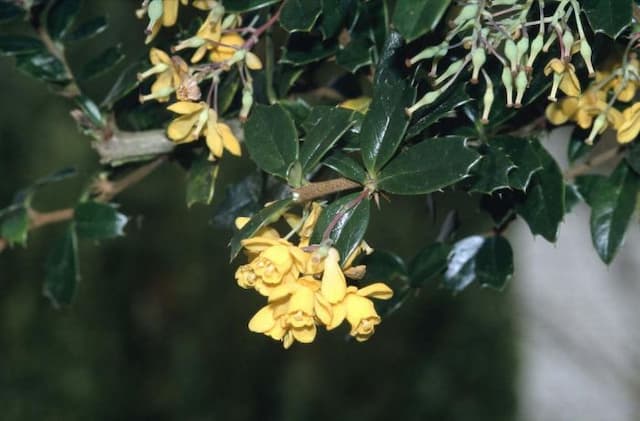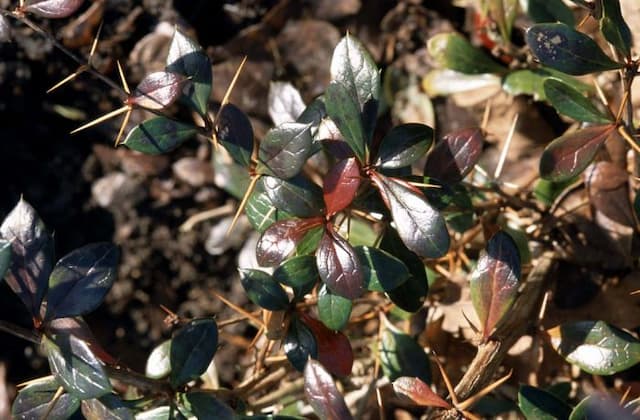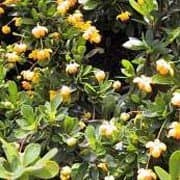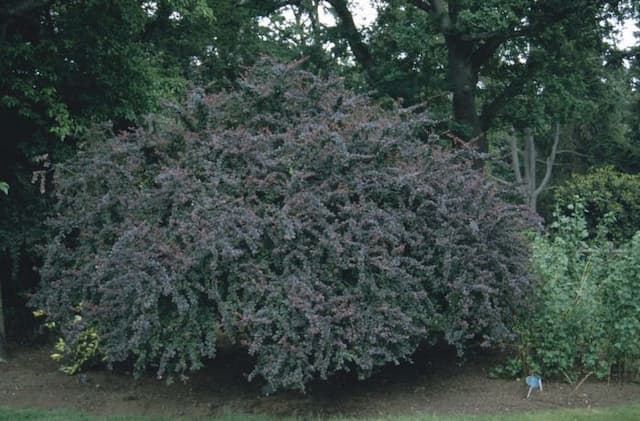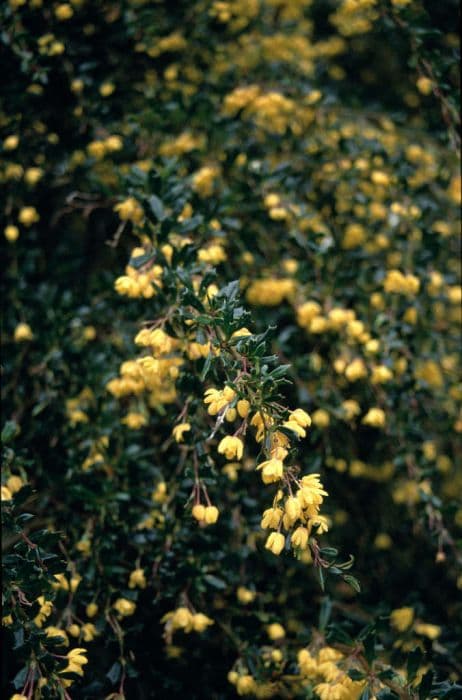Japanese Barberry Berberis thunbergii f. atropurpurea 'Rose Glow' (v)

ABOUT
The 'Rose Glow' barberry is a visually striking plant that is well-known for its colorful foliage. The young leaves emerge a vivid reddish-pink with mottled patterns of deeper purple and bronze shades, somewhat resembling the hues of a rose, hence the name 'Rose Glow'. As the leaves mature, they deepen in color, often transitioning to a rich purplish-red that adds a dramatic tone to the plant's appearance. The leaves themselves are small and oval-shaped with a slight texture, growing tightly around the thorny stems that characterize this barberry variety. These stems add an architectural element to the plant's form, creating a dense, compact shape that is tightly branched. In the springtime, the 'Rose Glow' barberry may produce small, inconspicuous flowers that are yellow in color. These flowers may be overlooked due to the prominence of the foliage. By autumn, the plant can bear tiny, bright red berries that stand out against the dark leaves and can persist into the winter, providing visual interest during the colder months as well as a food source for birds. The overall impression of the 'Rose Glow' barberry is of a striking plant that provides vibrant color and texture to gardens and landscapes with its unique foliage and seasonal changes. Its beauty lies in the dense clusters of colorful leaves and the contrast they offer throughout the growing seasons.
About this plant
 Names
NamesFamily
Berberidaceae
Synonyms
Rose Glow Japanese Barberry, Red Japanese Barberry, Rose Glow Barberry, Purple-leaved Japanese Barberry
Common names
Berberis thunbergii var. atropurpurea 'Rose Glow', Berberis thunbergii 'Rose Glow'.
 Toxicity
ToxicityTo humans
The plant commonly known as Japanese Barberry may present risks of toxicity if ingested by humans. While not considered extremely toxic, the berries and other parts of the plant can cause gastrointestinal upset, including nausea, vomiting, and diarrhea if eaten in large quantities. Care should be taken to prevent children from ingesting any part of this plant.
To pets
Japanese Barberry is also potentially toxic to pets. When ingested, pets may experience symptoms similar to humans, including vomiting, diarrhea, and general gastrointestinal distress. It is advisable to keep pets away from this plant to prevent the possibility of poisoning.
 Characteristics
CharacteristicsLife cycle
Perennials
Foliage type
Deciduous
Color of leaves
Variegated
Flower color
Yellow
Height
4-6 feet (1.2-1.8 meters)
Spread
4-7 feet (1.2-2.1 meters)
Plant type
Shrub
Hardiness zones
4-8
Native area
Japan
Benefits
 General Benefits
General Benefits- Ornamental Appeal: It adds visual interest to gardens with its vibrant red-purple foliage and attractive fall color.
- Low Maintenance: Once established, it is drought-tolerant and requires minimal care.
- Seasonal Interest: Offers year-round interest with flowers in spring, berries in summer, and autumn foliage.
- Dense Growth Habit: Can be used for hedging thanks to its thick, bushy growth.
- Wildlife Support: Provides food for birds with its berry-like fruits.
- Tolerance to Conditions: Adapts well to a variety of soil types and can handle urban pollution and salt spray.
- Erosion Control: Its root system can help stabilize slopes and prevent soil erosion.
- Privacy: Can be used as a natural privacy screen due to its dense foliage.
 Medical Properties
Medical PropertiesThis plant is not used for medical purposes.
 Air-purifying Qualities
Air-purifying QualitiesThis plant is not specifically known for air purifying qualities.
 Other Uses
Other Uses- As a natural fence or barrier: The dense and thorny nature of Japanese barberry 'Rose Glow' makes it an effective barrier plant to discourage trespassing animals and humans.
- Erosion control: Its extensive root system helps stabilize slopes and banks, reducing soil erosion in landscapes prone to erosion.
- Wildlife habitat: Although not a native species, its dense foliage provides shelter for birds and small mammals.
- Photography backdrop: The striking purple-red foliage can serve as a beautiful backdrop for outdoor photography.
- Winter garden interest: The plant retains its colorful leaves into the fall and sometimes throughout the winter, adding visual interest during the colder months.
- Theme gardens: Its unique color makes it suitable for gothic or 'black' themed gardens.
- Bonsai: With appropriate pruning, Japanese barberry 'Rose Glow' can be trained into a bonsai specimen.
- Contrast planting: It can be used to create contrast when planted alongside lime-green or golden foliage plants.
- Living sculpture: Through careful pruning, the shrub can be shaped into various forms, acting as a living art piece in the garden.
- Sound barrier: When planted in mass, its thick growth can help dampen noise from streets or neighbors.
Interesting Facts
 Feng Shui
Feng ShuiThe Japanese Barberry is not used in Feng Shui practice.
 Zodiac Sign Compitability
Zodiac Sign CompitabilityThe Japanese Barberry is not used in astrology practice.
 Plant Symbolism
Plant Symbolism- Protection: Berberis thunbergii, commonly known as Japanese barberry, is often associated with protection due to its thorny branches, which can act as a physical barrier against negative forces.
- Purity: The 'Rose Glow' variety, with its reddish-purple foliage that turns into deep, almost rose-like tones, can symbolize purity and cleansing, as its vibrant colors stand out in the garden, appearing unspoiled and untainted.
- Adaptability: Japanese barberry's ability to thrive in various soil types and its resistance to pests symbolizes adaptability to life's circumstances.
 Water
WaterThe Japanese barberry 'Rose Glow' should be watered deeply and less frequently to encourage the development of a strong root system. Water the plant with about 1 to 1.5 gallons of water every week during the first growing season to help it establish. Once established, the plant is drought-tolerant and will only need additional water during prolonged dry spells. Adjust watering during the hotter months, ensuring the soil does not dry out completely. It's preferable to water early in the morning to reduce evaporation and prevent the onset of any fungal diseases.
 Light
LightJapanese barberry 'Rose Glow' thrives in full sun to partial shade. A location that receives at least four to six hours of direct sunlight daily is ideal for optimum growth and foliage color. In hotter climates, some afternoon shade can help protect the plant from excessive heat stress.
 Temperature
TemperatureThe Japanese barberry 'Rose Glow' is quite hardy and can survive in a temperature range from -30 to 100 degrees Fahrenheit. The ideal temperature for this plant falls within the range of 60 to 70 degrees Fahrenheit during the growing season. It can survive winter lows to -30 degrees Fahrenheit, making it adaptable to various climates.
 Pruning
PruningPrune the Japanese barberry 'Rose Glow' to maintain its shape, remove any dead or diseased branches, and to promote air circulation within the plant. The best time to prune is in late winter or early spring before new growth starts. Prune selectively, thinning out crowded branches, to maintain a natural appearance. You may also prune immediately after flowering if required to control size.
 Cleaning
CleaningAs needed
 Soil
SoilThe Japanese Barberry 'Rose Glow' thrives in well-draining loamy soil enriched with organic matter. A slightly acidic to neutral pH of 5.5 to 7.5 is ideal for this plant. For the best soil mix, combine garden soil, compost, and peat moss or coarse sand to improve drainage.
 Repotting
RepottingJapanese Barberry 'Rose Glow' does not require frequent repotting and should be repotted every 2 to 3 years to refresh the soil. Make sure to use a larger pot only if the roots have outgrown the current one.
 Humidity & Misting
Humidity & MistingJapanese Barberry 'Rose Glow' is tolerant of a wide range of humidity levels and does not require specific humidity conditions. This plant can thrive in the average outdoor humidity levels found in its growing zones.
 Suitable locations
Suitable locationsIndoor
Keep in bright indirect light, ensure good air flow.
Outdoor
Plant in well-draining soil; full sun to part shade.
Hardiness zone
4-8 USDA
 Life cycle
Life cycleThe Japanese barberry 'Rose Glow', a variation of Berberis thunbergii marked by purple leaves and pink variegation, begins its life as a seed, often requiring cold stratification to break dormancy and germinate. Upon germination in early spring, the seedling emerges and establishes a root system, developing into a young shrub with characteristically colorful foliage. As the shrub matures, it undergoes a period of vegetative growth, wherein stems elongate and leaves expand, with the plant's distinct coloration becoming more prominent. In mid- to late spring, the shrub produces small yellow flowers arranged in clusters, which are pollinated by insects, leading to the formation of bright red berries that mature by fall and are important food sources for birds. Over several years, the 'Rose Glow' continues to grow in size and may require occasional pruning to maintain its shape and health. It is a perennial plant, so after the berries drop and leaves fall in autumn, it enters a dormant phase during winter, resuming growth again in the following spring.
 Propogation
PropogationPropogation time
Late Summer
The Japanese Barberry 'Rose Glow' is most popularly propagated using the method of softwood cuttings. This process typically occurs in late spring to early summer, when the new growth is still flexible but has begun to mature. Cuttings should be about 4 to 6 inches in length (10 to 15 centimeters) and include several sets of leaves. The lower leaves are removed, and the cut end is often dipped in a rooting hormone to encourage root development. The prepared cutting is then placed in a well-draining soil mix, ensuring that at least two sets of leaf nodes are buried. The environment should be kept humid, and within a few weeks, the cutting should begin to root, at which point it can be transplanted into a more permanent location.
